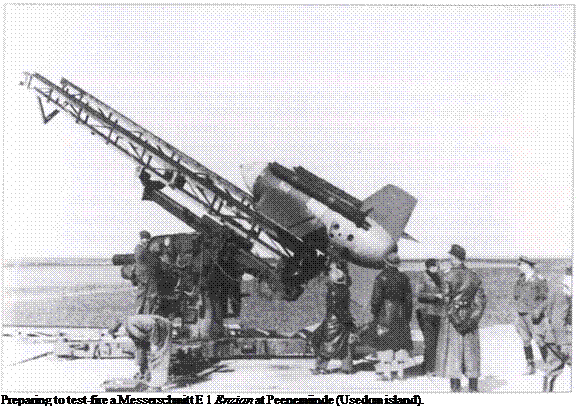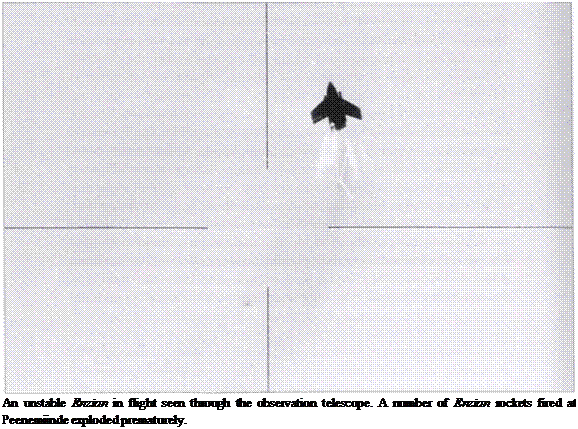Enzian
The Messerschmitt Enzian gave rise to great hopes. It was a subsonic, remote- controlled flak rocket for use against aerial targets at high altitude. Powerplant was an efficient liquid-fuel engine with four solid-fuel rocket boosters to aid take-off. The squat body was tailless, there being four large swept-back wings mid-fuselage having combined aileron/rudders.

After numerous early studies a full-size mock-up was begun in January 1944, the first experimental E 1 being completed at Augsburg in February 1944. After the factory was bombed that same month, production transferred to Holzbau Kissing at Sonthofen, this area being considered safer. After the first missile was delivered to Peenemiinde, it was test fired at Greifswalder Oie in mid-April 1944, the second on 29 April. On completion of the 38th test, Messerschmitt

considered the basic test series complete. After watching a demonstration at Peenemiinde West on 30 October 1944, Goring spoke out expressly in favour of Enzian since the equally prioritised Schmetterling was not yet ready.
By 1 November 1944,15 Enzian had been test fired. In a surprise move the entire project was then transferred to the Bavarian Alps under Dr Wurster, and the planning office set up on a farm at Schloss Lindhof. Two other Enzian (E 2) variants made in early summer 1944 to the earlier FR-6 design were fired from Greifswalder Oie in mid-November, but a really reliable flak rocket system still seemed far off. The Walter Werke motor rocket division at Beerburg was informed at the end of 1944 that their motor fell 35 per cent below the specified values: for this reason Enzian would receive the Rheintochter engine. A more efficient engine (on paper) designed by Professor Conrad of the Technical University of Berlin was also being considered: a first test run was expected in January 1945, but the date could not be met.
A 550-kg warhead was planned for Enzian. Dynamit Nobel of Hamburg supplied the first of these. Various detonators had been examined including the
modern Dogge. The project now fell well behind the RLM timetable, for the acute shortage of high-value metals prevented series production. On 19 December 1944 the Commission for Rocketry argued with the Chief-TLR against introducing Enzian because of the woeful technical problems, but despite this objection Askania was given a contract to provide new control mechanisms. It was hoped to test these from February 1945. With effect from 17 January 1945 OKL ordered the termination of the project since other developments were more promising and 450 man-hours per unit was excessive. On 6 Februarv Himmler withdrew his permission for further work on Enzian.
As the Red Army advanced, Greifswalder Oie was abandoned, the installations being prepared for destruction. Work on documenting the test reports was cut short at Schloss Lindhof in mid-March. A total of 60 Enzian rockets were completed and at least 24 test fired at Greifswalder Oie. The failure rate of these was relatively high at 70 per cent. Another 10 served for ground testing, 15 were blown up on 25 April at Sonthofen to prevent their capture. Almost all the remainder existed only in component parts. Most of the technical data were found by the Allies in underground galleries at Oberammergau and carted away.










